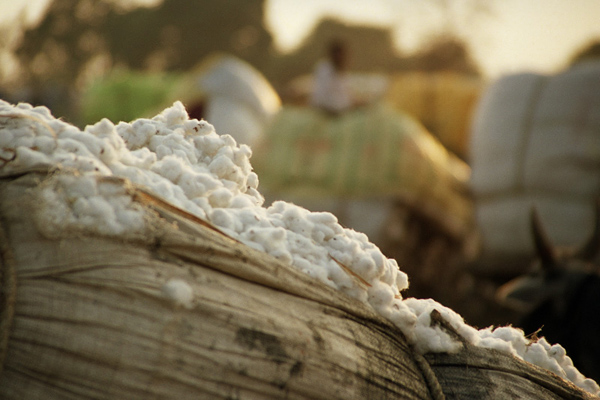Bloomberg: Egyptian cotton once dominated the colonial economy in the age of Queen Victoria, eventually becoming the gold standard for the world’s finest linens and clothing. Two centuries later, everyone from Martha Stewart to Christian Dior still prizes the supple fiber for its softness and durability.
In Egypt, not so much. Farmers are abandoning a crop that was as much a part of the nation’s identity as the Pyramids. They’re switching to grains because long-fiber cotton isn’t profitable without government aid, and cash subsidies are ending as the country wrestles with one of the biggest budget deficits in the Middle East. Production probably will tumble 35 per cent in the next season to the lowest on record, the US Department of Agriculture said.
“The quality characteristics are unique,” said Andrei Guitchounts, director of trade analysis at the International Cotton Advisory Committee in Washington. “If they lose this production, I don’t think any other producer can replicate it.”
Output has been declining for three decades as textile makers shift to cheaper, lower-quality fiber from Asia and fabrics like polyester. Demand for premium cotton accounts for less than 3 per cent of the global market, so Egypt figured subsidies for the crop didn’t make sense in a country that has become the world’s biggest wheat importer because it can’t grow enough grain to meet rising demand for bread.
‘Extremely Soft’
After a revolution in 2011 that ended the three-decade rule of President Hosni Mubarak, Egypt has struggled with political turmoil and the worst economic slump in two decades. The government cut energy subsidies and received $6 billion in aid from Saudi Arabia, United Arab Emirates and Kuwait this year.
The financial woes are escalating the demise of a raw material used in products like Westin hotel’s $490.50 king-sized sheets and shirts by Hugo Boss and J. Crew. Turnbull & Asser, the 130-year-old English clothes maker that has outfitted British royalty and James Bond, uses cotton grown in Egypt’s Nile Delta, according to the company’s website.
Egyptian cotton is considered the finest of all varieties because it produces an “extremely soft and supple” weave, as Martha Stewart says on her website. Its long fibers mean there’s less lint fuzz after washing, and the fabric holds up better over time. The strands are at least 35 millimeters (1.38 inches) long, compared with an average 27 millimeters for other varieties, the International Trade Center said.
Unique Characteristics
“We are very scared to lose this good cotton,” said Aldo Pienzi, a consultant at Albini Group, an Albino, Italy-based maker of fabric for designers including Hermes International and Christian Dior SE.
While not all finely-woven cotton is from Egypt, the country produces much of what is used by luxury manufacturers, Pienzi said.
Supplies from Egypt are among the most expensive. A variety known as Giza 86 was $1.12 a pound on June 19, according to Cotlook Ltd. data distributed by Supima, the U.S. producers association for high-grade pima cotton. The Cotlook A Index, a global benchmark for raw cotton, was 72 cents a pound.
Egyptian production has been slumping since reaching a record 2.49 million bales in 1970, according to the USDA. Output will drop this season to 340,000 bales, the third decline in four years and the lowest since USDA data began in 1960.
Rising Competition
The US, the other major supplier of premium cotton, has surpassed Egypt with pima, a variety grown mainly in California. The country will grow about 566,400 bales this season, about 40 per cent more than in 2009, the government estimates.
Top-quality fiber is a tiny part of the global market, which will produce 111 million bales next season, according to estimates from the USDA. Overall demand is expected to surpass production this year for the first time since 2010.
The government said in January it won’t provide cash subsidies next season because there’s not enough international demand and the crop is declining in quality, according to Eid Hawash, an agriculture ministry spokesman. Growers in 2014 were being paid 1,400 Egyptian pounds ($183.50) per feddan, the equivalent of about an acre.
Inferior Crops
The problem with the old system was that farmers added other kinds of cottonseed to boost production, leading to an inferior harvest, Hawash said in an interview. The government will now provide only seed and fertilizer to farmers that have sales contracts with buyers before the season begins.
That means fewer subsidies because exporters and weaving firms won’t agree on a price before the crop is grown, according to Mefreh El-Beltagi, head of the cotton exporters association. Smaller farmers, or those with less than five feddans of land, will be pushed out because they can’t get a sales contract, El-Beltagi said in an interview in Alexandria.
Sabry Hassafy, 34, said he’s cutting back on cotton that his family has grown for three generations in the northern Beheira province. This season, he sowed cotton on one feddan, down from 10 last year, and may give it up entirely next season to focus on corn and fodder crops. His cotton will earn about 6,000 Egyptian pounds, offset by 3,000 pounds of labour costs, 1,000 pounds for fertilizer and 2,000 pounds for water and seed.
“Cotton for my grandfather and father was a very lucrative crop,” Hassafy said. “It was a source of national pride to farmers. Now, everyone avoids it.”


